|
|
|
Sort Order |
|
|
|
Items / Page
|
|
|
|
|
|
|
| Srl | Item |
| 1 |
ID:
151664
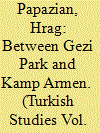

|
|
|
|
|
| Summary/Abstract |
This paper uses theories of intersectionality to study Nor Zartonk, an activist group of Istanbulite youths which is mostly comprised of Armenians. Based on ethnographic research, it first explores and analyzes the youths’ subjectivities, ideology, and activism, exposing their intersectional nature. Furthermore, through the study of this particular case the paper identifies some general potentials of intersectional positionality: first, that the politicization of one dimension of individuals’ intersectional subjectivities could pave the way for the politicization of others; second, that intersectional activists could ‘intersectionalize’ the events in which they participate, thus potentially pluralizing the socio-political implications of those; and third, that different dimensions of intersectional activism could support each other in practice and essence.
|
|
|
|
|
|
|
|
|
|
|
|
|
|
|
|
| 2 |
ID:
188164
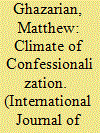

|
|
|
|
|
| Summary/Abstract |
After the 1877–78 Russo-Ottoman War, the Ottoman Empire saw the rise of ethnic and sectarian clashes in Anatolia, the Balkans, and elsewhere, and the task of explaining that rise remains unfinished. Many have examined the intellectual formations of ethnic and sectarian solidarities after 1878, but the availability of new ideas cannot alone account for their widespread uptake. Why after 1878 did ordinary people respond more to calls upon ethnic and sectarian solidarity? Drawing on sources surrounding the 1879 famine in the Ottoman East, this article steps away from imperial metropoles to examine overlapping environmental, financial, and technological disjunctures. Adopting the methods of political ecology, the article underscores the simultaneous effects of drought, sovereign default, and an influx of modern weapons, each of which imposed uneven hardships along ethno-religious lines. Together, they created a climate of lived confessionalization that highlighted the communal categories upon which emergent movements called.
|
|
|
|
|
|
|
|
|
|
|
|
|
|
|
|
| 3 |
ID:
174598
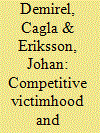

|
|
|
|
|
| Summary/Abstract |
This paper argues that conflicts tend to be intractable if collective victimhood has become a component of national identity, and when conflicting communities claim to be the ‘real’ or ‘only’ victims, and that their suffering justifies crimes past and present. Turkish and Armenian narratives of competitive victimhood are analysed drawing on public opinion polls from Turkey and Armenia, and personal interviews with Turks and Armenians. The study corroborates past theory and research that competitive victimhood prevents reconciliation, particularly if it has become an essential part of national identity. The paper also shows that Turkish–Armenian relations remain at the bottom stage of the reconciliation ladder. Yet, some of our empirical observations suggest that when grass-roots level interaction between Turks and Armenians is facilitated (which has been prevented not least because of the closed border), there is room for the abandonment of competitive victimhood at least on an interpersonal level, if not on a general societal or political level.
|
|
|
|
|
|
|
|
|
|
|
|
|
|
|
|
| 4 |
ID:
186580
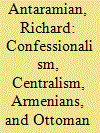

|
|
|
|
|
| Summary/Abstract |
This article argues that non-Muslim engagement with 19th-century Ottoman reform should be understood in the context of a confessionalized politics that originally fostered partnerships of governance in the 18th century. The confessionalization of non-Muslim communities in the 18th century, which resulted in the political empowerment of Istanbul-based ethnarchs, promoted the establishment of robust communal boundaries that were more legible to the central state. These arrangements also made non-Muslim communities such as the Armenians partners in governance, responsible for supporting the state's effort to maintain its place atop a contentious imperial politics. The Tanzimat reforms, which reorganized non-Muslim communities and devolved some power from the clergy to the laity, were not a novelty, but instead a renegotiation of non-Muslims’ roles in the centralization of state. Rather than embrace secularized identities, non-Muslims enthusiastically used their own religious institutions to promote state centralization. In the process, they reconfigured relations of power in the region that left non-Muslims structurally marginalized.
|
|
|
|
|
|
|
|
|
|
|
|
|
|
|
|
| 5 |
ID:
120280
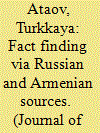

|
|
|
| 6 |
ID:
120069
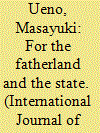

|
|
|
|
|
| Publication |
2013.
|
| Summary/Abstract |
This article examines Ottoman Armenian attitudes toward the Tanzimat reforms, particularly in relation to the situation of provincial Armenians. Even though implementation of the reforms was slow and marked by setbacks, the promises embedded in them raised expectations of change among Armenians in both Istanbul and the provinces. In response, individuals in these areas equipped themselves with knowledge of the language and principles of the Tanzimat. They interpreted and utilized these for their own purposes, sometimes not as the Ottoman government intended. In this sense, the Tanzimat was not merely a top-down state project; it was also pluralized through interactions between the government and its subjects. Exploring how non-Muslims negotiated the Tanzimat enables reconsiderations of the Muslim-elite-centered historiography on the reforms.
|
|
|
|
|
|
|
|
|
|
|
|
|
|
|
|
| 7 |
ID:
086739
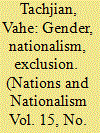

|
|
|
|
|
| Publication |
2009.
|
| Summary/Abstract |
This essay focuses on the process of 'rebuilding' the Armenian nation in the newly constituted states of the Middle East (Syria, Lebanon, Palestine, and Iraq) in the immediate aftermath of World War I. These efforts were centred on the two largest sectors of the population to have survived the Catastrophe, orphans and familyless (or widowed) women. The essay examines the ideology of 'national reconstruction' and some of its internal contradictions. It pays particular attention to both Armenian women who married Muslims during the deportations and the children born of these marriages, as well as to Armenians who turned to prostitution to survive in the complex conditions prevailing in this period. The author makes use of extensive, previously neglected archival material: for example, correspondence by some of the principal actors, reports written during the process of locating and rounding up Armenian orphans, and documents that shed light on life within the walls of orphanages and women's shelters. The author assembled this archival material in Paris, Beirut, Aleppo, and Cairo, after surveying the contents of various archives.
|
|
|
|
|
|
|
|
|
|
|
|
|
|
|
|
| 8 |
ID:
163883
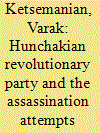

|
|
|
|
|
| Summary/Abstract |
The spring of 1894 was an important period for Constantinople's Armenian community. Two assassination attempts targeted the Armenian patriarch Khoren Ashekian, and the chairperson of the Armenian Political Assembly Maksudzade Simon Bey, respectively. In both cases, the assailants were partisans of the Hunchakian Party, an Armenian revolutionary organization established in 1887. Analyzing the reasons behind these two attacks, and the imperial context in which they took place, this article challenges aspects of mainstream Armenian and Turkish historiography on the Hamidian period. It argues that a critical look at these two attacks through a socio-economic paradigm rather than an ethno-political one provides a viable analytical framework for deconstructing the notion of the “Armenian millet” as an undifferentiated community. More generally, the article explores the role of violence in shaping intracommunal relationships in the early 1890s.
|
|
|
|
|
|
|
|
|
|
|
|
|
|
|
|
| 9 |
ID:
160435
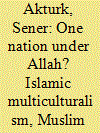

|
|
|
|
|
| Summary/Abstract |
A number of reforms and initiatives, undertaken by the Justice and Development Party (AKP or AK Party) governments in Turkey, widely known as Kurdish and Alevi ‘openings,’ and the less prominent non-Muslim (primarily Armenian and Jewish) openings, have puzzled scholars as to their causes, consequences, and limitations. In this article, I first briefly review four different kinds of analytical accounts that seek to explain the AK Party’s openings. Second, I introduce my argument that an Islamic conceptualization of a new religious-national identity is both the main motivation and the main limitation of these reformist initiatives. Third, I provide an analysis of critical speeches, official statements, and declarations by AK Party leaders, in particular by Recep Tayyip Erdoğan, on the Kurdish, Alevi, and non-Muslim openings, demonstrating that they invoke overwhelmingly religious justifications.
|
|
|
|
|
|
|
|
|
|
|
|
|
|
|
|
| 10 |
ID:
098362
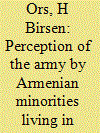

|
|
|
| 11 |
ID:
165300
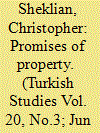

|
|
|
|
|
| Summary/Abstract |
The policies of the Turkish Justice and Development Party (AKP) towards religious minorities exhibits a fundamental ambiguity. Though the AKP has supported a number of high-profile changes in policy towards Armenians and other non-Muslim minorities, the party has left the underlying legal structure intact. This article describes developments in the treatment of non-Muslim vakıfs (often translated at ‘religious foundations’) under the AKP, specifically the restoration of the Holy Cross Armenian Cathedral on the island of Akdamar and the reopening of the Surp Giragos Armenian Church in Diyarbakır. Using these examples, the article demonstrates how the tension between changing policy and enduring legal structure points to an ‘ambiguous attitude’ on the part of the AKP towards Turkey’s religious minority populations.
|
|
|
|
|
|
|
|
|
|
|
|
|
|
|
|
| 12 |
ID:
174902
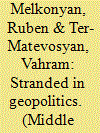

|
|
|
|
|
| Summary/Abstract |
The Republic of Turkey of the 1920s and 1930s was a complex place to live. Kemalism came to nurture and embrace a new citizen who had no other choice but that of being a Turk as stipulated by the 1924 constitution. It was particularly challenging for Christian minorities, or what was left of them, because of ultra-nationalism and the highly ideological nature of the one-party regime of the Kemalist era. Many Armenians, who chose to stay or had to stay in Turkey, were not at ease with the existing state of affairs. Most of them were still looking for ways to leave Turkey for safer places. It became a particular matter of contention in the initial years of the Cold War when the Soviet Union launched a policy of encouraging Turkish Armenians to migrate to Soviet Armenia. Based on Russian, Turkish, and Armenian sources, the article presents hitherto unexplored features of that policy.
|
|
|
|
|
|
|
|
|
|
|
|
|
|
|
|
|
|
|
|
|